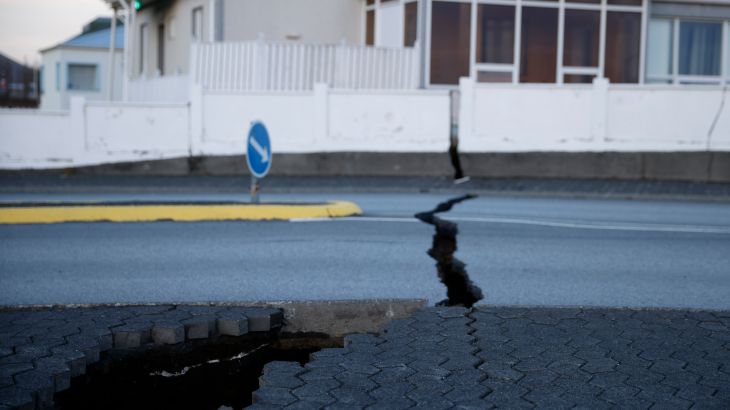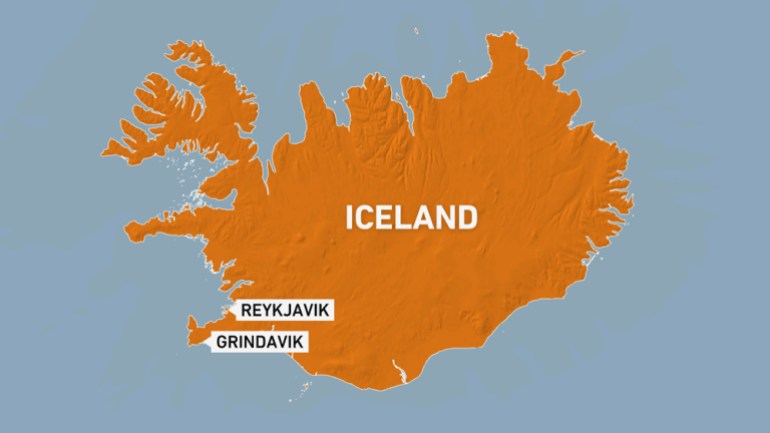Iceland volcano: What happens if it erupts?
Residents of Grindavik have evacuated the town as the threat of a volcanic eruption looms over Iceland.

Iceland, which has 33 active volcanic systems, declared a state of emergency and ordered the mandatory evacuation of the town of Grindavik on Saturday.
Here is what to know:
Keep reading
list of 1 itemWhere is Grindavik and what is happening there?
Grindavik is a fishing town on Iceland’s southwestern peninsula of Reykjanes. It is home to 3,800 people. Around 900 earthquakes hit southern Iceland on Monday alone, adding to the tens of thousands of tremors that have shaken up the south of the country in recent weeks.
Grindavik residents described being evacuated from their homes by police in the early hours of Saturday as the ground shook, roads cracked and buildings suffered structural damage.
Scientists have linked these earthquakes to the movement and spreading of magma, which is around 5km (3 miles) underground. Land in the region has risen by 9cm since October 27, according to the Icelandic Meteorological Office.
Authorities fear that molten rock can rise to the surface and hit Grindavik. Experts expect an eruption soon since the magma is at a shallow depth.
The Icelandic Meteorological Office said on Monday there was a “significant likelihood” of an eruption in the coming days on or just off Reykjanes, despite the size and intensity of earthquakes decreasing.

What precautionary measures are being taken?
The residents were told to leave Grindavik on Saturday and were allowed to briefly return on Sunday to collect their belongings including documents, medicines or pets, with Icelandic police and civil protection vehicles on standby.
Almost all of the town’s residents found accommodation with family members or friends. Only between 50 and 70 people were staying at evacuation centres, a rescue official told the Reuters news agency.
The Blue Lagoon geothermal spa, a tourist attraction in Iceland also announced its temporary closure until November 16. The spa is located on the peninsula, “amid moss-covered lava fields”, according to its website.
Scientists are monitoring the situation to examine the flow and proximity of the magma to try to predict the likelihood of eruption.
On Tuesday, the authorities were preparing to build defence walls around a geothermal power plant in the southwestern part of the country that they hope will protect it from lava flows in the event of an eruption.
What can happen if the volcano erupts in Iceland?
The lava can potentially threaten the town of Grindavik and the Blue Lagoon. Geothermal pipelines that supply hot water to thousands of homes are also under threat.
There also might be a risk of toxic fumes and air pollution as a result of the eruption.
“We have a fissure that’s about 15km [9.3 miles] long, and anywhere on that fissure we can see that an eruption could happen,” Vidir Reynisson, head of Iceland’s Civil Protection and Emergency Management told the AFP news agency.
However, the end of the fissure goes into the sea, which means the eruption can occur on the ocean floor, which would likely cause a large ash cloud.
Volcanic eruptions also pose a serious hazard to aviation because they can spew highly abrasive ash high into the atmosphere where it can cause jet engines to fail, damage flight control systems and reduce visibility.
Has this happened in Iceland before?
Iceland sits above a volcanic hotspot in the North Atlantic and averages an eruption every four to five years.
The 2010 eruption of the Eyjafjallajokull volcano was one of the most disruptive eruptions recently, resulting in widespread airspace closures over Europe and costing airlines an estimated $3bn as they cancelled more than 100,000 flights.
After 800 years, three eruptions have taken place on the peninsula of Reykjanes near the Fagradalsfjall volcano: in March 2021, August 2022 and July 2023. Previous eruptions did not cause damage, having occurred in remote valleys.
Volcanologists believe the new cycle of increased activity could last for several decades or centuries.
Is the capital Reykjavik at risk?
Grindavik is around 40km (25 miles) southwest of Iceland’s capital, Reykjavik, where authorities have not ordered residents to evacuate, indicating that they do not think the country’s biggest city will be impacted by an eruption.